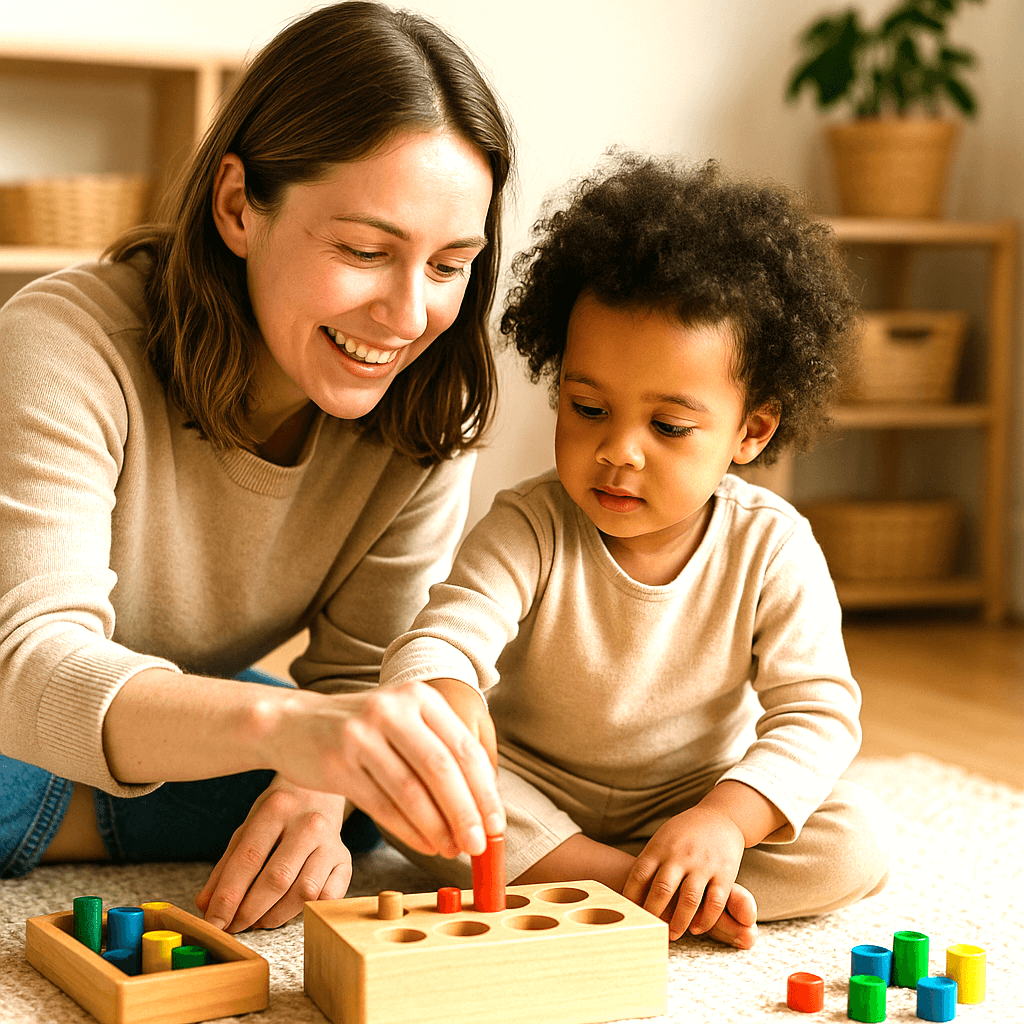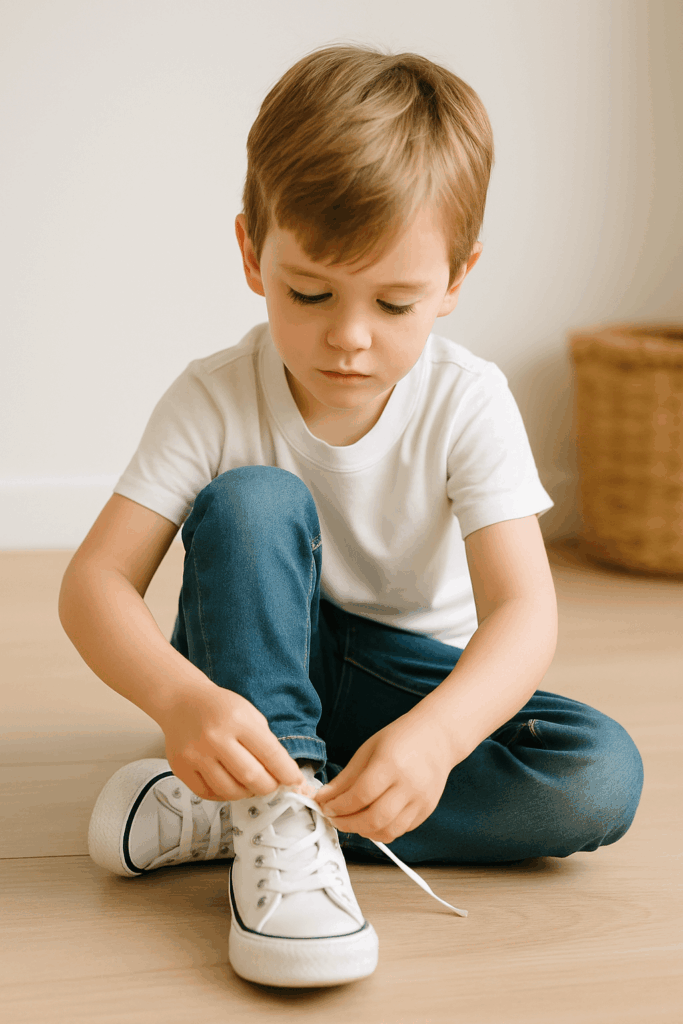
Foundations for Life: What Happens in the First Three Years of Childhood
Why the First Three Years Matter More Than You Think And How to Support Your Child’s Unique Journey
Raising babies and toddlers is a profound, demanding, and often misunderstood task. Amidst the messes, tantrums, sleepless nights, and unpredictable routines lies a phase of development so powerful it shapes a child’s entire life. In the first three years, your child’s brain is absorbing language, emotion, values, and movement in ways that are fundamentally different from how older children and adults learn.
This isn’t just a developmental phase, it’s a once-in-a-lifetime opportunity. Practicing Montessori parenting and understanding your child’s human design during these early years can transform how we parent: with more clarity, joy, and trust and help us become truly grounded parents who raise confident children.
Why We Love and Struggle With Babies and Toddlers
Parents often describe their little ones as cute, funny, curious, and affectionate, yet also impulsive, clingy, chaotic, and emotionally intense. This duality is real and valid. But through a Montessori lens, we begin to see these behaviors not as obstacles but as evidence of deep learning, rich internal lives, and incredible capability.
Let’s explore five key traits that make babies and toddlers so unique:
1. They Live in the Present
Babies and toddlers are completely immersed in the moment. Unlike adults, they’re not planning the future or dwelling on the past. A simple walk can become a deeply enriching experience as they stop to observe a weed, a car, or a passing plane. They remind us to slow down, look closer, and share their wonder.
2. They Are Authentic
Children this age haven’t yet learned to mask their feelings or manipulate others. When a toddler says something honest, even if it embarrasses us, they’re simply observing their world. Their emotional transparency is a gift—and a mirror.
3. They Are Enormously Capable
From peeling bananas to identifying landmarks at just 18 months old, toddlers demonstrate surprising competence. Their determination, especially around tasks involving “maximum effort” like carrying heavy items or helping with chores, is a natural drive toward mastery.
4. They Are Well-Meaning
Even when toddlers act out or seem defiant, their intentions are rarely malicious. Much of their behavior is impulsive exploration. With our support and modeling, they gradually learn patience, turn-taking, and emotional regulation.
5. They Don’t Hold Grudges
Babies and toddlers recover quickly from emotional upsets. Their capacity for forgiveness and fresh starts is something we can learn from. After a tantrum or disagreement, they’re often ready to reconnect—no resentment, just presence.
The Absorbent Mind: A Superpower Unique to Early Childhood
Dr. Maria Montessori described the young child’s brain as the “absorbent mind.” From birth to age 3, this absorption is unconscious. Children are not trying to learn; they simply do, effortlessly acquiring language, emotional tone, and social behaviors from their environment.
What They Absorb:
- Language: Up to 8 months old, babies can distinguish sounds from any language. After that, they focus on those they hear regularly.
- Movement & Emotion: Babies mimic not only how we move but how we behave. They adopt our tone, energy, and even our stress.
- Values & Attitudes: If we speak kindly, respond gently, and act respectfully, our children will absorb that. If we rush, snap, or react, they will absorb that too.
This means that everything from how we close a drawer to how we handle conflict becomes part of their internal world. It’s not about being perfect—it’s about being intentional.
Sensory Learning and Prepared Environments
Children under age six are sensorial learners. They take in the world through touch, taste, sight, sound, and smell, not lectures or abstract explanations.
Practical Ways to Support Sensory Learning:
- Let babies explore nature, watching leaves move, touching grass, or smelling fruit at a market.
- Involve toddlers in real tasks like food prep, wiping spills, or carrying their own bag.
- Use simple, natural toys that encourage interaction and concentration, not passive entertainment.
Prepared environments, whether a calm corner with a mirror or a shelf with just a few trays, offer children independence, beauty, and order.
Human Tendencies: The Inner Drive of Children
Montessori identified several universal tendencies that drive all humans from birth:
- Movement: Children need space and permission to move freely.
- Exploration: Babies and toddlers explore by touching, mouthing, crawling, climbing.
- Order: Predictable routines and consistent environments help them feel secure.
- Orientation: They learn by having reference points, knowing where things belong and what to expect.
- Communication: From crying to gesturing to first words, communication is constant and evolving.
When these needs are blocked by high chairs, screens, or over-scheduling, frustration and behavioral challenges often arise.
Sensitive Periods: Windows of Intense Interest
Sensitive periods are times when children are particularly drawn to certain activities or skills. From birth to age 3, they include:
- Movement
- Language
- Order
- Sensorial exploration
- Small objects
- Social interaction (emerges closer to age 3)
During these windows, children show incredible focus and joy. Following their interests—whether it’s vehicles, animals, or colors—leads to deeper learning and self-discovery.
Independence and “Help Me to Help Myself”
True independence starts not with self-reliance but with collaboration. Dressing a baby becomes a shared experience, “Can you pass me your arm?” A toddler pouring water, wiping a spill, or helping set the table gains confidence, skill, and joy from participating in real life.
Functional independence includes:
- Dressing
- Feeding
- Toileting
- Cleaning
- Helping others
It’s not about pushing children to do things alone—it’s about offering the tools, support, and time to practice until they’re ready.
Emotional Safety and Co-Regulation
Babies and toddlers build two psychological legs:
- Trust in themselves (through trial, error, and mastery)
- Trust in others (by being consistently responded to with love)
When a child is melting down, it’s not “bad behavior”, it’s a stress response. They need to borrow our nervous system to calm theirs. We co-regulate through calm presence, soft words, and safe limits. This lays the foundation for lifelong resilience.
Montessori Tools for Parenting with Clarity and Joy
Here’s how to bring this all together in your home:
1. Observe Before Acting
Step back. What is your child telling you through their actions? What are they learning? Observation helps us respond with clarity instead of reaction.
2. Prepare the Environment
Low shelves, soft lighting, natural materials, accessible tools. Rotate toys and limit clutter. Make beauty and calm accessible to your child.
3. Use Soft Hands and Respectful Language
Speak to even the youngest baby with kindness. Tell them what you’re doing. Respect their body, their pace, and their emotional needs.
4. Balance Freedom with Clear Limits
Freedom allows exploration. Limits provide safety. “I won’t let you hurt your brother” and “You may carry this carefully with two hands” are both forms of loving guidance.
5. Take Care of Yourself
You cannot pour from an empty cup. Self-care isn’t indulgence, it’s essential. Whether it’s five minutes of silence, a cup of tea, or a walk outside, find what fills you up.
Babies and toddlers are not just surviving, they are constructing their very being. With each wobbly step, tearful tantrum, and joyful discovery, they’re forming the foundation for who they will become. And we, as their caregivers, have the privilege to walk beside them, not to mold them, but to guide them.
Montessori invites us to see our children and ourselves with new eyes: not as problems to be fixed, but as potential unfolding before us.
Your challenge: What’s one insight you’ll take into your parenting this week? Whether it’s speaking before you act, using your “soft hands,” or simply slowing down to observe, remember: small changes have a lifelong impact.

Connection Before Correction: Building Trust and Cooperation in the First Three Years
Parenting young children is one of life’s greatest privileges and one of its greatest challenges. For many caregivers, guiding a child’s behaviour often turns into a battleground of yelling, frustration, and confusion. But what if there were another way? What if the secret to cooperation wasn’t more correction, but more connection?
We explore how respectful communication, emotional awareness, and intentional parenting can transform daily struggles into moments of growth, for both you and your child.
Before They Speak, They Communicate
Even before a child can use words, they are constantly communicating. Through cries, gestures, behaviour, and facial expressions, young children express their needs, emotions, and desires. When these cues are misunderstood or ignored, the result is often resistance, tantrums, or withdrawal.
We need practical tools and a new mindset to truly connect with our children, especially in moments of stress.
The Connection-Cooperation Cycle
Children are more likely to listen, follow instructions, and regulate their emotions when they feel deeply connected to the adults in their lives. When connection breaks down, through yelling, threats, or emotional distance so does cooperation.
A common negative cycle many parents find themselves in:
- Parent is tired, stressed, or overwhelmed.
- Child behaves in a challenging way.
- Parent reacts impulsively: yelling, blaming, threatening, or giving in.
- Connection breaks.
- Child acts out even more to regain attention and connection.
- Parent becomes more exhausted… and the cycle continues.
To change this, we must replace the cycle with a positive one:
- Stay grounded in calm.
- Use tools like validation, choice, and gentle redirection.
- Reconnect before correcting.
- Build trust and skill through respectful communication.
Shift Your State of Mind
You can’t parent effectively from a place of exhaustion and reactivity. That’s why the first step in connection-based parenting is not changing your child, it’s regulating yourself.
There are four layers of connection
- Connection with Yourself – Are you grounded, present, and emotionally regulated?
- Connection with Each Child – Does your child feel seen, safe, and valued?
- Connection with Your Partner – Is there shared alignment in your parenting approach?
- Connection Between Siblings – Are you nurturing empathy, fairness, and respect among your children?
Each of these layers requires intention, practice, and repair when things go wrong. Connection isn’t a one-time achievement, it’s a continual process of showing up and rebuilding trust.
Emotional Intelligence Doesn’t Come With Age
One of the biggest misconceptions in parenting is that children will naturally “grow out of” tantrums, defiance, and emotional outbursts. But these are not simply age-based issues, they’re skill-based.
Children don’t automatically become emotionally resilient, respectful, or confident. These are learned behaviours that require modeling, coaching, and lots of practice.
- What is my child missing in this moment?
- What emotional skill could help them navigate this better?
- How can I model that skill right now?
Mindset, Strategy, Connection, and Skill-Building
- Mindset – Reframe your thoughts to see your child as good, capable, and coachable.
- Strategies – Use Montessori-informed tools like choice-giving, rhythm charts, validation, and peaceful spaces.
- Connection – Build and repair your bond through empathy, shared experiences, and attuned listening.
- Skill-Building – Use everyday moments to strengthen your child’s emotional intelligence, self-regulation, communication, and problem-solving.
When these four elements are in place, cooperation becomes a natural outcome—not a battle to be won.
In Practice: The Blue Cup Moment
One common scenario many parents face is the “blue cup meltdown.” A child wants a specific cup, it’s not available, and a tantrum ensues. Our instinct is to solve the problem by giving in, but this actually weakens the child’s emotional resilience.
Instead, you can use such moments to build flexibility and problem-solving. Instead of rushing to fix or distract, parents can validate feelings and support the child in choosing a different option, strengthening the “flexibility muscle” over time.
Practical Tools and Takeaways
Here are some actionable tools that you can use:
- Give yourself the time-out first. Recalibrate before engaging.
- Reflect on what your child is learning from each interaction.
- Use co-regulation strategies, not coercion: offer calm presence, not control.
- Create an emotional first aid kit with your child: activities and tools they can use when upset.
- Model emotional resilience by sharing your process: “I’m feeling frustrated, so I’m going to take a few deep breaths.”
- Stop repeating yourself. Say things once and follow through with action.
- Use mirror neurons. Do routines alongside your child, rather than ordering them from afar.
Connection before correction is not a soft or permissive approach, it’s a powerful and strategic way to raise children who listen, learn, and love deeply. It asks more of us as adults, but gives back tenfold in the form of stronger relationships, greater cooperation, and lifelong emotional intelligence.

Creating the Blueprint for Confident Kids and Grounded Parenting
If you’ve ever felt like your toddler bounces from toy to toy, constantly demands your attention, or seems inexplicably bored, you’re not alone. Many parents find themselves frustrated and exhausted trying to keep up with their child’s energy and needs. But what if the problem isn’t your child’s behavior or your parenting skills, but rather the environment they’re growing up in?
In Montessori education, we speak of a powerful triangle: the child, the prepared environment, and the prepared adult. When these three elements are thoughtfully aligned, children flourish and parenting becomes more peaceful.
What Is a Prepared Environment?
A prepared environment is more than a tidy playroom or attractive shelf, it’s a space designed with deep intention. It meets the developmental needs of your child, empowers their independence, and supports calm, focused engagement. Here’s how:
- Child-Centered Design: Furniture and tools are accessible to your child. Their view of the world matters, literally. If you crouch down to their level, what do they see? Can they reach what they need? Can they move freely and choose their own activities?
- Freedom Within Limits: Montessori promotes choice, but within respectful boundaries. Children are free to act as long as they show respect for themselves, others, and their environment. These clear, consistent limits create security and reduce power struggles.
- Order and Consistency: Children thrive on predictability. A consistent setup allows them to return to familiar activities and deepen their focus. Toy rotation can support this by removing items they’re not engaging with and reintroducing materials that align with their interests.
- Purposeful, Self-Correcting Materials: Montessori activities are designed so that children can see and correct their own mistakes. This builds critical thinking and problem-solving skills. Puzzles, pouring activities, or dressing frames give them immediate feedback and encourage perseverance.
- Aesthetically Pleasing and Calm: Children, like adults, are sensitive to overstimulation. Calm, uncluttered spaces with soft lighting and neutral tones support regulation and reduce chaos.
- Real-Life Practical Opportunities: Children don’t just want to play, they want to participate. Providing tools to sweep, prepare food, or set the table gives them a sense of agency and purpose.
- Promotes Independence and Responsibility: Children need tools to be self-sufficient, towels to wipe their faces, step stools to reach the sink, hooks at their height for jackets. When they can do things for themselves, they feel proud and confident.
Why Independence Matters
Building independence isn’t just about giving your child chores. It lays the groundwork for their long-term confidence, self-worth, and resilience. Here’s how:
- It Builds Confidence: When children do things for themselves, whether it’s putting on their shoes or pouring a glass of water they feel a sense of mastery. These small victories are huge for their self-esteem.
- It Fosters Problem-Solving: If we always step in to help, we rob children of the chance to work through challenges. Struggling (a little) is how they learn.
- It Reduces Frustration and Power Struggles: When children aren’t allowed to make choices or contribute meaningfully, they often rebel. Giving them autonomy over age-appropriate decisions, like which of two outfits to wear or how to help clean up can prevent unnecessary battles.
- It Encourages Cooperation: When we trust our children with responsibility, we communicate respect. This mutual respect strengthens our relationship and their willingness to work with us.
As Montessori wrote, “Any child who is self-sufficient, who can tie his shoes, dress or undress himself, reflects in his joy and sense of achievement the image of human dignity.”
Common Pitfalls: How We Hinder Independence
Without meaning to, we often limit our child’s independence:
- Overprotecting: When we fear messes, accidents, or mistakes, we jump in too fast. But every dropped glass or crooked shirt is a learning opportunity.
- Interrupting: Children concentrate deeply in play. Interrupting their focus for minor reasons disrupts their development of attention span and problem-solving.
- Doing Too Much: Speed and efficiency drive adult life. But when we do everything “just to get it done,” we prevent our children from learning how.
- Making All the Decisions: Giving children no voice in their daily routines can lead to resistance. Offer structured choices and let them have a say.
How to Help Your Child Be More Independent
- Involve Them in Decisions: Even small choices build confidence. “Do you want to brush your teeth before or after your bath?” gives structure and autonomy.
- Create an Accessible Space: Even in small homes, you can provide a step stool, a low shelf, or a mirror and wipes within reach.
- Slow Down: Yes, it’s faster if you do it. But independence takes time. Offer opportunities for your child to try at their own pace.
- Encourage Responsibility: After a meal, let them clear their own plate. If they spill, hand them a towel and say, “Would you like this towel or that one to help clean up?”
These daily moments build self-reliance and emotional resilience.
The Prepared Adult: Your Role in the Process
The prepared environment supports the child. But the prepared adult holds everything together. Your emotional regulation, your mindset, and your habits directly influence how your child feels and behaves.
Many parents struggle with:
- Self-doubt: Am I good enough? Am I doing this right?
- Emotional overload: Especially when your child’s emotions are running high.
- Conflicting advice: From books, social media, relatives—everyone seems to have an opinion.
So how do we stay grounded?
- Observe Before Acting: Slow down. Don’t rush to fix or judge. Notice your child’s body language. Wait before intervening.
- Communicate Respectfully: Yelling might work in the short-term, but it erodes trust. Practice calm, intentional responses: “I see you’re angry. Let’s keep our hands to ourselves.”
- Model Behavior: Children learn from what we do. Your ability to stay steady teaches them emotional regulation more than any lecture.
- See Your Child as Capable: Trusting them is the first step to helping them trust themselves.
- Connect Through Play: Just 15–20 minutes of uninterrupted, intentional play can transform your relationship and their behavior.
Parenting Without a Manual But With a Framework
Parenting is the only life-altering job with no training. We prepare for driving, for careers, even for hobbies. But parenting? We’re thrown in the deep end.
Montessori doesn’t give you a script, but it does give you a framework. A way to understand your child’s needs, respond with clarity and calm, and support their growth toward independence and confidence.
When you combine this approach with understanding your child’s unique human design then you are able to create a blueprint for your child’s unlimited success in life.
I’d love to help you learn more about yourself and your child through grounded parenting and human design. Understanding both your own and your child’s Human Design offers a powerful lens for grounded, attuned parenting. By recognising your child’s natural energy, decision-making style, and ways of learning or engaging with the world, you can support them in becoming who they truly are, rather than who they feel pressured to be. At the same time, knowing your own design helps you stay regulated, clear, and aligned in your role as a parent. This mutual awareness fosters deeper connection, reduces power struggles, and lays the foundation for raising confident, emotionally secure children who trust themselves and their unique path.


0 Comments
Leave a comment